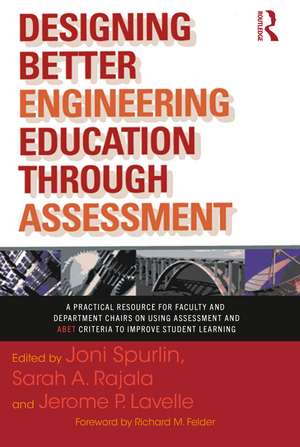Designing Better Engineering Education Through Assessment: A Practical Resource for Faculty and Department Chairs on Using Assessment and ABET Criteria to Improve Student Learning
Editat de Joni Spurlin, Sarah A. Rajala, Jerome P. Lavelleen Limba Engleză Paperback – 22 feb 2008
Preț: 287.41 lei
Nou
Puncte Express: 431
Preț estimativ în valută:
55.00€ • 57.35$ • 45.71£
55.00€ • 57.35$ • 45.71£
Carte tipărită la comandă
Livrare economică 20 martie-03 aprilie
Preluare comenzi: 021 569.72.76
Specificații
ISBN-13: 9781579222130
ISBN-10: 1579222137
Pagini: 384
Dimensiuni: 152 x 229 x 24 mm
Greutate: 0.52 kg
Ediția:1
Editura: Taylor & Francis
Colecția Routledge
Locul publicării:Oxford, United Kingdom
ISBN-10: 1579222137
Pagini: 384
Dimensiuni: 152 x 229 x 24 mm
Greutate: 0.52 kg
Ediția:1
Editura: Taylor & Francis
Colecția Routledge
Locul publicării:Oxford, United Kingdom
Public țintă
Postgraduate and Professional Practice & DevelopmentCuprins
Foreword—Richard M. Felder; Preface; Acknowledgements; ABET Criteria for Accrediting Engineering Programs; PART ONE. BASICS OF ASSESSMENT. 1. Understanding the Nature and Purpose of Assessment—Linda Suskie; 2. Assessing Student Learning. Ensuring Undergraduate Students Are Learning What We Want Them to Learn—Joni E. Spurlin, Sarah A. Rajala and Jerome P. Lavelle; 3. Assessment Methods Used in Undergraduate Program Assessment—Joni E. Spurlin; 4. Using Assessment Results for Improving Student Learning—Barbara M. Moskal; 5. Tools and Assessment Methods Specific to Graduate Education—J. Joseph Hoey; PART TWO. BARRIERS AND CHALLENGES. 6. Barriers and Challenges to Assessment in Engineering Education—J. Joseph Hoey and Eleanor W. Nault; 7. Overcoming Resistance to Change—Sherra E. Kerns and Karan Watson; PART THREE. LEARNING ALONG THE CONTINUUM OF THE EDUCATIONAL EXPERIENCE. 8. Assessing the First Year of Engineering Education—Jerome P. Lavelle and Sarah A. Rajala; 9. Assessment for Improving Teaching and Student Learning within a Course—C. Dianne Raubenheimer; 10. Using Formative Assessment for Program Improvement—Barbara M. Olds and Ronald L. Miller; 11. The Capstone Experience at the Baccalaureate, Masters and Doctorate Levels—David G. Meyer; PART FOUR. THE FUTURE. 12. The Future of Assessment—Mary Besterfield-Sacre and Larry J. Shuman; Glossary; Contributors; Index. Advisory Board. Mary Besterfield-Sacre, Associate Professor and Fulton C. Noss Faculty Fellow, Department of Industrial Engineering, University of Pittsburgh J. Joseph Hoey, Vice President for Institutional Effectiveness, Savannah College of Art and Design Mike Leonard, Senior Associate Dean and Professor, School of Engineering, Mercer University Eleanor W. Nault, Director of Assessment, Office of Institutional Assessment, Clemson University C. Dianne Raubenheimer, Director of Assessment, College of Engineering, North Carolina State University
Notă biografică
Joni Spurlin is University Director of Assessment and Associate Director of University Planning & Analysis at North Carolina State University. Sarah A. Rajala is James Worth Bagley Chair and Head of the Department of Electrical and Computer Engineering at Mississippi State University. Jerome P. Lavelle is Assistant Dean of the College of Engineering at North Carolina State University. Richard M. Felder
Recenzii
"It serves as a practical guide and introduction to improving the assessment process, which is a necessary component of the ABET requirements related to student outcomes and assessment. The work describes various assessment methods and provides examples of various assessment tools that have been utilized by a variety of programs. Valuable for faculty and administrators who are concerned with satisfying the ABET accreditation requirements in engineering and technology programs. Recommended."
Choice
“What has been missing is a resource that takes effective assessment techniques developed by social scientists, education scholars, and statisticians, and recasts them in terms that are both clear and clearly relevant to engineering education. This is such a resource. In my opinion, it succeeds admirably.”
Richard M. Felder, Hoechst Celanese Professor Emeritus of Chemical Engineering
North Carolina State University
Choice
“What has been missing is a resource that takes effective assessment techniques developed by social scientists, education scholars, and statisticians, and recasts them in terms that are both clear and clearly relevant to engineering education. This is such a resource. In my opinion, it succeeds admirably.”
Richard M. Felder, Hoechst Celanese Professor Emeritus of Chemical Engineering
North Carolina State University
Descriere
This book is written for engineering faculty and department chairs as a practical guide to improving the assessment processes for undergraduate and graduate engineering education in the service of improved student learning. This book concludes with a vision for the future of assessment for engineering education.
